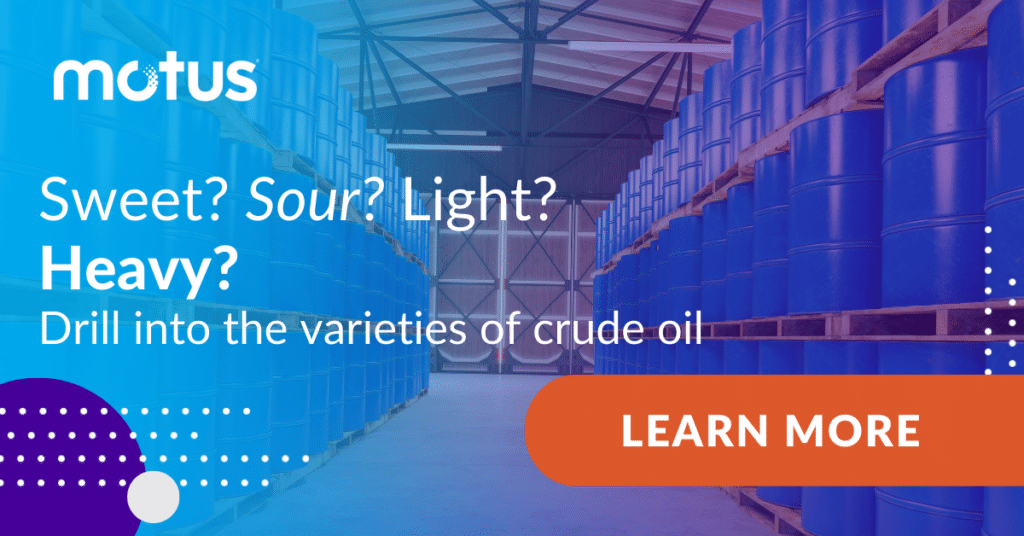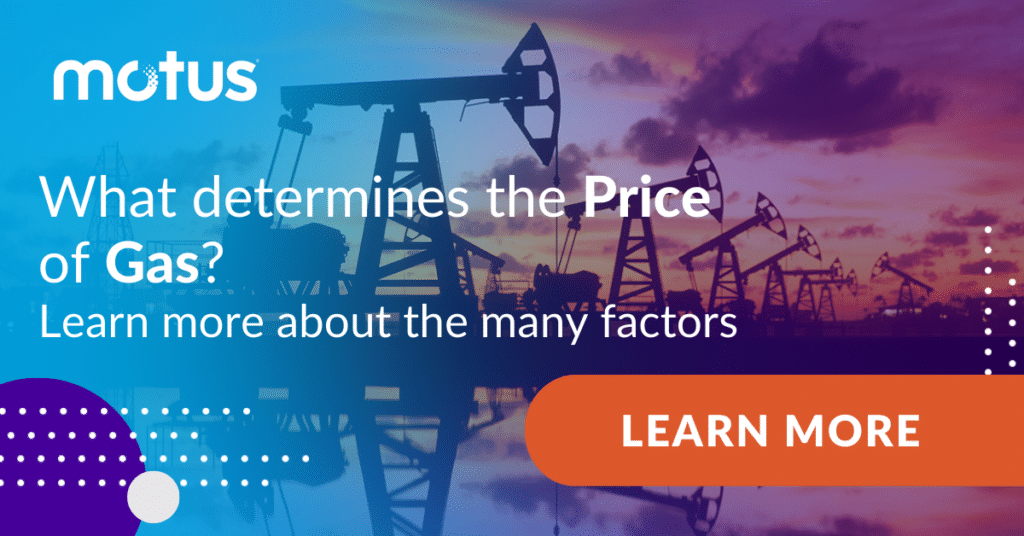You know gasoline. It’s that pale brown or pink fluid used to fuel vehicles with internal combustion engines. Vehicles like cars, trucks, jets and ATVs. It also fuels lawnmowers, generators, heating systems and aerosol sprays. You might not know refiners use it in the production of some plastics, rubbers and pharmaceuticals as well. But how is gasoline made?
Gasoline is made by breaking down crude oil into petroleum products through fractional distillation, after which the usable gasoline is transported to gas stations via pipelines. As of today, gasoline is among the most commonly used petroleum products, comprising approximately half of the products in use. In this blog, we answer some fundamentals like how gasoline is made and how outside forces influence its price.
What Is Gasoline? Physical Properties
Gasoline is a product of refined crude oil. It is a highly flammable, energy-dense liquid that evaporates quickly. This makes it somewhat dangerous to handle, but perfect for igniting in an engine. It mixes with air to create a combustible mixture that gets your car going. To get molecular, gasoline is made up of a mixture of hydrogen and carbon atoms. The composition depends on the refining process and the original source. Producers may include additives to improve gasoline’s longevity and performance.
Wondering how gasoline vs petrol stack up? Well, wonder no more. Petrol and gasoline are different names for the same thing. So if you’re traveling abroad and not sure what to put in the tank, there’s your answer.
Speaking of fueling up, you may notice at the gas pump that gasoline has an octane rating. This is a measure of its resistance to detonation in the engine. Higher octane indicates greater resistance to premature detonation that can damage engines.
Where Does Gasoline Come From?
As mentioned earlier, gasoline begins as crude oil, a fossil fuel. Fossil fuels are the carbon-rich remnants of dead animals and plants that have been pressurized and heated at high temperatures underground for millions of years. The end product is crude oil, natural gas or coal.
There are many processes and phases involved in gasoline production and its subsequent delivery to gas stations. For this reason, the U.S. Energy Information Administration doesn’t attempt to pinpoint where fuel from local gas stations originates. Generally, it begins as crude oil within a petroleum refinery, where it is broken into other components.
After that, it moves through several refining stages and is transported through pipelines to storage terminals near consumption areas. Finally, tanker trucks move the gasoline from storage to smaller terminals where fuel ethanol is blended into gasoline for motor vehicles. From there, tanker trucks deliver the finished gasoline to over a hundred thousand gasoline retail locations.
How Is Gasoline Made?
We can go back even earlier in the process to nail down how oil is made, but that’ll take a much longer explanation. To summarize, crude oil is the byproduct of a bunch of organic material exposed to heat and compression over millions of years. It’s what’s referred to as a fossil fuel. Crude oil needs to be refined to become the gasoline we use every day. To get scientific, the hydrocarbons present in crude oil must be separated and purified to be usable in an internal combustion engine. Turning crude oil into gasoline requires a few steps. Those steps include sourcing the raw material, transporting it to refineries, and taking it through the refining process before transporting it to gas stations for distribution. Let’s dig into the main phases of the refining process, starting with sourcing the raw material.
Pumping Crude Oil
Crude oil is a combination of hydrocarbons found underground, often in formations of porous rock. It comes in several variations, such as light, medium, heavy, and extra-crude. Each differs in viscosity, density and sulfur content. Companies obtain crude in several ways.
The primary extraction process involves bringing oil to the earth’s surface by using the natural pressure of the reservoir. A secondary method, known as fracking, uses steam, water or gas to increase ground pressure and force the oil out. Another way this can be done is by adding chemicals to the reservoir to change the physical properties of the oil so it comes out of the ground more easily. Once the crude is pumped, it needs to be transported.
Transporting Crude
Crude oil has a long journey from the well to refineries and storage facilities. It can be transported by pipeline, train or tanker. companies prefer pipeline networks, as they’re the safest, most affordable way to move crude oil over long distances. Tankers are used when the oil needs to be transported across the ocean. Trains are another method, though the high risk of spills and other accidents makes it less ideal than other options.
Employees in the energy sector have a tremendous responsibility to protect people and the environment by preventing these devastating oil spills and leaks. Failure results in environmental damage, risks to public health and economic losses. Hopefully new technologies and safety practices currently being developed can prevent these disasters from happening in the future.
Refining Crude
Refining crude oil involves turning this raw material into usable petroleum products. Those products include diesel, jet fuel, heating oil and, of course, gasoline. During refining, the components of crude oil are separated based on their boiling points. This allows for the production of products with distinct physical properties. Because the various types of crude oil require different refining levels, the gasoline process depends on the type of crude oil being processed.
Premium and regular gasoline are the two most common types of gasoline produced during the refining process, as they yield better engine performance for vehicles. Ethanol is sometimes added to reduce emissions and boost fuel efficiency, but this addition can also influence performance and necessitate different refining methods. The refining process is broken down broadly below.
Distillation
In the first stage, crude oil is taken to a distillation tower to be heated and vaporized. Separated hydrocarbons create various components as they cool and condense at various temperatures and different levels of the distillation tower. Heavy asphalt and tar hydrocarbons condense at the bottom while light natural gas hydrocarbons collect at the top.
Cracking
The second stage cracks and breaks down larger hydrocarbon molecules into smaller ones used to produce gasoline. This process ensures the gasoline has desirable properties, like low sulfur content and a high octane rating. Refineries use two methods. One is catalytic cracking, which uses a catalyst to speed up the breakdown of larger molecules. The other is thermal cracking, which heats the oil to high temperatures.
Blending
Once distillation and cracking are complete, refiners selectively blend hydrocarbons together based on the end user’s needs. Those needs include altitude, season and vehicle type. The blending process determines the gasoline’s properties, including volatility and emissions characteristics. Most gasoline has 5 to 15 hydrocarbons, each with unique properties and performance characteristics. This allows refineries to create various blends for unique needs and applications.
What Determines the Price of Gasoline?
Maybe you’re wondering “who controls gas prices?” But it’s not so simple: no one person is responsible for the price of gas. A broad spectrum of factors influence gasoline prices. These factors include natural market forces of supply and demand, the price of crude oil, marketing costs, processing costs, taxes, federal policy and re-seller markup. The cost of crude oil makes up over half the cost of gasoline. Oil producers may decide to slow production or decrease supply, which drives up the price of crude oil per barrel. Geopolitical events can also slow production and diminish supply. This happened with the Colonial Pipeline ransomware attack and the Texas Freeze. For these reasons it can be difficult to anticipate gasoline prices, or bring them down.
Geopolitical Implications
Being a major producer and exporter of crude oil has decreased U.S. dependence on foreign oil and gas imports. This has helped the nation achieve energy security and stay out of foreign political conflict for many years. The growth of the domestic oil sector also contributes job and economic growth and helps the U.S. compete in the global market, challenging giants like Russia and Saudi Arabia that have long dominated the sector. But the oil industry is still subject to global events. The war in Ukraine, for example, has been a major disruptor to the industry, contributing to a spike in gasoline prices all over the U.S. and abroad.
Oil Reserves
The world’s largest crude oil reserves are located in the Middle East. At the end of 2021, the United States had the 11th largest reserve in the world, with 44.4 billion barrels available in oil-rich states. Those states include Alaska, Texas and North Dakota. Offshore reserves in the Gulf of Mexico and the Arctic have also bolstered the U.S. oil supply. Established in 1975, the Strategic Petroleum Reserve (SPR) is a national reserve of crude oil and petroleum products that serves as a backup. This is to stabilize gas prices during emergencies or in case of oil supply disruption.
As of February 2023, much of the crude oil available in these reserves has been sold off. Now, only 372 million barrels remain available for wartime or emergency. The amount, the lowest available amount since 1983, is only enough to meet the United States gasoline needs for a little over a month.
Environmental Impact
On the other side of the coin, crude oil is a finite resource that the world cannot rely on forever. That’s part of the reason the U.S. is striving to use more renewable energy sources. What’s more, burning fossil fuels, including gasoline, releases carbon dioxide and other greenhouse gasses into the atmosphere. These emissions threaten to warm the earth to dangerous temperatures. The extraction, transportation and refining of crude oil can also result in oil spills, habitat destruction and other environmental impacts. For these reasons, the government and the marketplace are pushing to phase out crude oil and other fossil fuels for cleaner, more sustainable alternatives.
The Future of Gasoline
Despite the increasing popularity of electric vehicles (EVs), gasoline is still critical to the global market and has no end yet in sight. Until sustainable options are both affordable and convenient, consumers will continue relying on gasoline-powered vehicles for transportation. However, as the EV market grows and develops, the demand for gasoline may slow. Unfortunately, the Organization of Petroleum Exporting Countries (OPEC) takes advantage of this. To ensure they receive a high price per barrel, they inflate prices by reducing production.
In the end, the future of gasoline will hinge upon environmental, economic and technological factors and developments. Interested in learning more around the topic of oil and its impact? Check out our Oil Check content!
Frequently Asked Questions Around Gasoline
Is there a difference between gasoline from big brand names and small retailers?
Gasoline from no-name gas stations used to be considered cheap and low-quality. Today, however, gasoline brands primarily differ in terms of the cleaning additives they offer, as well as the unique components that make up the gasoline. There isn’t one brand that’s better for every vehicle, as everyone has unique driving habits and a car with individual needs. Seek out the one that is best for your engine according to the owner’s manual that came with your vehicle. This is usually indicated by the octane rating.
How do summer and winter blends differ?
During the winter, cold temperatures cause gasoline to be thicker, which makes it more difficult to vaporize and ignite. Winter gasoline blends have incorporated high levels of light hydrocarbons that can evaporate more easily for higher volatility. Summer blends, in contrast, have lower levels of light hydrocarbons for lower volatility so that the gasoline doesn’t evaporate too quickly and contribute to air pollution and reduced fuel economy.
Are gas additives worth it?
A common misconception among vehicle owners is that additives can magically boost your fuel efficiency. What fuel additives really do is clean and protect the fuel system and the integrity of the gasoline and prevent rust. This reduces the likelihood of buildup that can reduce engine performance and fuel efficiency. Common examples of fuel additives include corrosion inhibitors, fuel stabilizers, and detergents. These prevent rust, gasoline degradation while in storage and clean the fuel system.
Should I select premium or mid-grade fuel?
Premium-grade gasoline contains the same ethanol content and is no more powerful or quality than mid-grade fuel. It’s simply more detonation-resistant. This may be required for certain vehicles like luxury cars, high-performance trucks, and sports cars. Those vehicles need gasoline to withstand higher temperatures without premature detonation so the engine doesn’t sustain damage.









